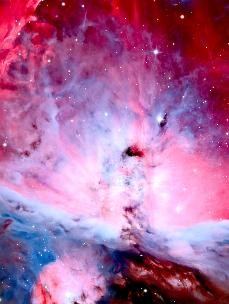A converted Cat Tran winds its way up the twisted snowy passage to the summit of Mt. Lemmon, where the UA Mt. Lemmon SkyCenter sits over 9,000 feet above sea level. At the top, visitors emerge to begin a journey that will take them across the universe.
“”Tonight’s presentation is about perspectives,”” program coordinator Adam Block said to the crowd as he kicked off the evening. “”Our solar system, the nearest stars, and beyond.””
The Jan. 16 special program, titled “”Our Place in the Universe,”” aimed to give participants a grasp of the scale of the universe, from our own sun 93 million miles away to a quasar galaxy 5 billion light years away.
“”The views I’ll be giving you are as good as they get”” Block said. “”There is no one else doing what I am trying to do tonight.””
Block graduated from the UA with a degree in astrophysics in 1995.
The SkyCenter is a non profit public outreach organization, run by the UA College of Science and Steward Observatory. Located atop the tallest peak in the Coronado National Forest just north of Tucson, their public programs are designed to teach people more about astronomy and work done by UA researchers.
The special “”Our Place in the Universe”” program costs participants $60, but regular events cost $48 and include a meal.
Originally used as a military radar facility during the Cold War, the Mt. Lemmon summit is now a premier site for astronomical research and opened up for public programs in April 2008.
The Korea Astronomy and Space Science Institute also rents a neighboring facility and operates a telescope remotely from halfway across the world.
“”It’s the highest peak in the area with the greatest telescope and the nicest skies. What more do you want out of life?”” SkyNights volunteer Dale Cupp said. He has worked as a volunteer since September and assists in the operational aspect of the program.
“”It’s something I’ve always wanted to do,”” Dale said. “”Amateur astronomers always want a bigger telescope.””
Before the stargazing began, Block gave a presentation on the scale of the universe to give guests a sense of how Earth fits into the system.
To illustrate the first unit of distance, the group ventured out onto the mountain’s edge where they looked over the snowy forest and into the setting sun.
Block taught them why shadows are blue and they viewed the distorted image of the “”green rim”” seen at the moment the sun sets.
As night fell, the group entered the SkyNights facility where a 30-foot diameter dome rotates overhead to display the night sky. It houses a 24-inch RC Optical Systems telescope used only for public programs.
This summer Block said the SkyNights program will receive a new 32-inch telescope donated from private contributions.
“”I’ll show you which stars are the closest, which stars are the furthest, which ones will blow up!”” Block said.
Guests huddled around the telescope, viewing stars and galaxies as they were taken on a tour of the universe, spanning out from the perspective of our own planet.
“”Looking through the eyepiece takes patience and perseverance,”” Block said. “”We are always looking back in time.””
Unsheltered from the icy breeze atop the mountain, visitors also participated in a stargazing session and used star charts to locate constellations, and even galaxies, with their naked eyes.
Block timed the stargazing session so, at 6:26 p.m., viewers caught what he said was a special sight.
“”Can you see that thing moving?”” Block asked the crowd while pointing above. “”That is not a star. That is the International Space Station! There are people up there.””
As temperatures plummeted below 30 degrees, participants sought refuge in the “”warm room”” adjacent to the telescope. Block took pictures of deep sky objects with a charge-coupled device camera attached to the telescope, and printed a one-minute exposure photo of the Orion nebula for them to take home as a souvenir.
The SkyNights program usually runs four nights a week, and attracts people from across the country, he said.
Danielle Goodman and her father Don Goodman flew in from Marietta, Ga. to participate in the SkyNights program and tour the UA, where Danielle was just accepted into the engineering program for next fall.
“”I just like space,”” said Danielle Goodman, who later got to operate the dome’s mechanical roof.
“”It’s interesting to see it firsthand. I watch a lot of it on the science channels. It’s more educational. It starts to sink in when you see it yourself,”” Don Goodman said.
Ken Pieti traveled “”vagabond style”” in a motor home from Detroit, Mich., to participate in the SkyNights program. He said the rural atmosphere provided him with a rare opportunity to gaze up into the night sky.
Pieti said, “”There’s no stars left in Motown.””









